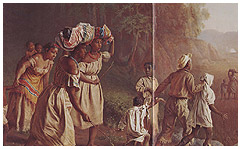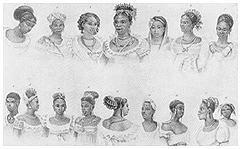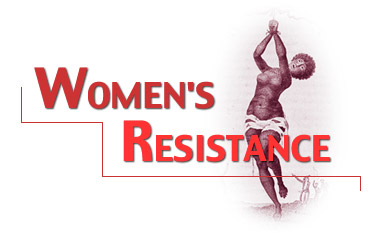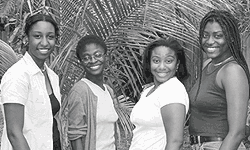In order to understand where you are going, you first have to know where you came from. This idea was of great importance to us when we chose this topic. Not only are we women, but black women whose past is obviously relevant in our every day lives. In attempting to gain an understanding in the Caribbean slave woman’s role in resistance, there was a need for substantial research, but we found that there was a lack of relevant primary sources. This lack of information only reaffirms our belief that society during slavery days regarded the black enslaved woman as inferior and of little importance. Not only did it become important to shed light on the past, but also to recover the stories hidden by centuries of misunderstanding and undervaluing of the independence and strength of Caribbean women.
 This paper will focus on resistance to slavery among Caribbean women. A secondary focus will be on Caribbean women’s culture, relationships with other slaves and her "superiors," and the punishments to which she was subjected due to her resistance. Before we attempt to discuss these different aspects, we first have to define the forms of resistance. Here we group resistance into two categories: active and passive. Passive resistance involves the following: Slow working, pretending ignorance and deliberate carelessness. Active resistance is more vigorous and has immediate results. Such actions were more rare because of the penalties involved. Some of these were: refusing to engage in copulation with the master, damaging and destroying owners’ property, (whatever machinery, livestock, burning of mills); stealing and the most active of all, murder and revolt. This paper will focus on resistance to slavery among Caribbean women. A secondary focus will be on Caribbean women’s culture, relationships with other slaves and her "superiors," and the punishments to which she was subjected due to her resistance. Before we attempt to discuss these different aspects, we first have to define the forms of resistance. Here we group resistance into two categories: active and passive. Passive resistance involves the following: Slow working, pretending ignorance and deliberate carelessness. Active resistance is more vigorous and has immediate results. Such actions were more rare because of the penalties involved. Some of these were: refusing to engage in copulation with the master, damaging and destroying owners’ property, (whatever machinery, livestock, burning of mills); stealing and the most active of all, murder and revolt.
During our research we found that we had to peel away many layers before reaching the core of active resistance. Many of these layers were laid down by enslaved women themselves, who worked resistance into all the aspects of their culture and tradition. One example of this phenomenon might be the practice of religion, a major part of life for Africans who were brought into the Caribbean. When forbidden to continue the practice of this aspect of their culture on the plantation, traditional religious practices then took on a deeper meaning for Caribbean slaves. Through religion and dance, they were able to release themselves to their gods and at the same time engage in a form of passive resistance. At the forefront of all this were enslaved women, who passed down and kept alive a disproportionate amount of the cultural heritage of Africa that survived in slavery. They did so through their roles as mothers and healers, daughters and workers. They were, in short, strong women who felt it their duty to uphold traditional values.
In many African cultures, women were honored and this attitude towards them did not change within the Caribbean. Many of the religious rites and rituals took on an altered form in the Caribbean, but the role of women was constant. The proof is in the legacy that has been left behind. The same customs that enslaved Africans brought with them are still present today. For instance, women have handed down lessons through the art of storytelling, an art which they have maintained. Their stories tell of ancient people in ancient times but the morals are relevant even today, as are told in the Haitian folktale "Ti Malice" or the Jamaican folktales of "Anansi." Another part of life still present today is the art of hair braiding, an ancient African tradition, which has always created a bond between mothers and their children. As with cooking, it had to be taught and cultivated in order for them to have substance, and it often provided the occasion for other kinds of instruction.
Slave women's reactions to and experience within slavery were different than that of the African male slave. Like her Caribbean male slave counterpart, "Quashee," "Quasheba" actively resisted the repressive and dehumanizing stranglehold of slavery. But enslaved women devised ingenious ways of rebelling that were distinctively their own. These forms of resistance were often actions that related to them particularly as women: resistance against sexual assault; resistance through the passing on of traditions to daughters and other young women; resistance through the distinctively female (in the Caribbean) activity of marketing. Within the restrictions imposed upon the slave woman in Caribbean slave plantation society, her actions in resistance are such that they could be considered an active form of resisting.
 In other cases, enslaved women broke the bonds of not only slavery, but the stereotypes of black womanhood as well. The enslaved black woman’s slave narrative, such as that written by former slave Mary Prince, is an example of this active form of resistance. Here, in her own words, the enslaved black woman tries to dispel the mythic stereotypes of the scheming, lazy "Quasheba." In Quasheba’s place, she presents herself, industrious, resourceful, and productive. Here, in her very own words, given the domestic, social, and economical restriction inherent in slave plantation society, the slave woman proclaims herself as the sole authority over her status, her life, and what her legacy to future generations will be. In other cases, enslaved women broke the bonds of not only slavery, but the stereotypes of black womanhood as well. The enslaved black woman’s slave narrative, such as that written by former slave Mary Prince, is an example of this active form of resistance. Here, in her own words, the enslaved black woman tries to dispel the mythic stereotypes of the scheming, lazy "Quasheba." In Quasheba’s place, she presents herself, industrious, resourceful, and productive. Here, in her very own words, given the domestic, social, and economical restriction inherent in slave plantation society, the slave woman proclaims herself as the sole authority over her status, her life, and what her legacy to future generations will be.
Prince’s narrative could not by itself defeat things like the sexual exploitation of African women in the Caribbean, the misery and theft of labor in the cane fields, or the harsh punishments and tortures dreamed up by white slave owners and overseers. Nor could it by itself alleviate the misery of the countless women who watched malnourished children die before they ever got to listen to a story or have their mothers braid their hair. We could easily conclude that the female slave’s misery was endless. We could conclude that the distinctively female forms of passive and active forms of resistance mentioned here were not very effective, or did not do much to eliminate the real economic and physical constraints of slavery. In thinking of resistance, perhaps religion and dance are not the first examples that would come to mind. But we also have to remind ourselves that cultural imperialism was a significant way in which Europeans tried to strip slaves of their dignity. Therefore, in discussing slave resistance, it is important to recognize one of the things that made slaves feel they could no longer live as slaves, that being tradition. Since women upheld tradition, it is also important to acknowledge their contribution to the struggle. Once you have an understanding of your roots, you have the ability to grow stronger, stand firm in your beliefs and are now capable to help others in their quest for self-empowerment. The ability of the black Caribbean slave woman to withstand punishments, maintain cultural identity, resist the master, and to take on various authoritative roles is the essence of true resistance. And the black Caribbean slave woman passed on her power, beauty and strength to her descendants in the form of a legacy of dignity and struggle, one still much needed in the world today.
|






